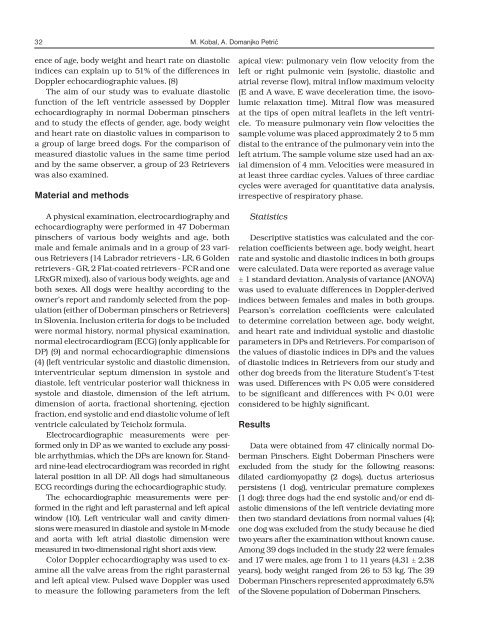Slov Vet Res 2007; 44 (1/2) - Slovenian veterinary research
Slov Vet Res 2007; 44 (1/2) - Slovenian veterinary research
Slov Vet Res 2007; 44 (1/2) - Slovenian veterinary research
You also want an ePaper? Increase the reach of your titles
YUMPU automatically turns print PDFs into web optimized ePapers that Google loves.
32 M. Kobal, A. Domanjko Petrič<br />
ence of age, body weight and heart rate on diastolic<br />
indices can explain up to 51% of the differences in<br />
Doppler echocardiographic values. (8)<br />
The aim of our study was to evaluate diastolic<br />
function of the left ventricle assessed by Doppler<br />
echocardiography in normal Doberman pinschers<br />
and to study the effects of gender, age, body weight<br />
and heart rate on diastolic values in comparison to<br />
a group of large breed dogs. For the comparison of<br />
measured diastolic values in the same time period<br />
and by the same observer, a group of 23 Retrievers<br />
was also examined.<br />
Material and methods<br />
A physical examination, electrocardiography and<br />
echocardiography were performed in 47 Doberman<br />
pinschers of various body weights and age, both<br />
male and female animals and in a group of 23 various<br />
Retrievers (14 Labrador retrievers - LR, 6 Golden<br />
retrievers - GR, 2 Flat-coated retrievers - FCR and one<br />
LRxGR mixed), also of various body weights, age and<br />
both sexes. All dogs were healthy according to the<br />
owner’s report and randomly selected from the population<br />
(either of Doberman pinschers or Retrievers)<br />
in <strong>Slov</strong>enia. Inclusion criteria for dogs to be included<br />
were normal history, normal physical examination,<br />
normal electrocardiogram (ECG) (only applicable for<br />
DP) (9) and normal echocardiographic dimensions<br />
(4) (left ventricular systolic and diastolic dimension,<br />
interventricular septum dimension in systole and<br />
diastole, left ventricular posterior wall thickness in<br />
systole and diastole, dimension of the left atrium,<br />
dimension of aorta, fractional shortening, ejection<br />
fraction, end systolic and end diastolic volume of left<br />
ventricle calculated by Teicholz formula.<br />
Electrocardiographic measurements were performed<br />
only in DP as we wanted to exclude any possible<br />
arrhythmias, which the DPs are known for. Standard<br />
nine-lead electrocardiogram was recorded in right<br />
lateral position in all DP. All dogs had simultaneous<br />
ECG recordings during the echocardiographic study.<br />
The echocardiographic measurements were performed<br />
in the right and left parasternal and left apical<br />
window (10). Left ventricular wall and cavity dimensions<br />
were measured in diastole and systole in M-mode<br />
and aorta with left atrial diastolic dimension were<br />
measured in two-dimensional right short axis view.<br />
Color Doppler echocardiography was used to examine<br />
all the valve areas from the right parasternal<br />
and left apical view. Pulsed wave Doppler was used<br />
to measure the following parameters from the left<br />
apical view: pulmonary vein flow velocity from the<br />
left or right pulmonic vein (systolic, diastolic and<br />
atrial reverse flow), mitral inflow maximum velocity<br />
(E and A wave, E wave deceleration time, the isovolumic<br />
relaxation time). Mitral flow was measured<br />
at the tips of open mitral leaflets in the left ventricle.<br />
To measure pulmonary vein flow velocities the<br />
sample volume was placed approximately 2 to 5 mm<br />
distal to the entrance of the pulmonary vein into the<br />
left atrium. The sample volume size used had an axial<br />
dimension of 4 mm. Velocities were measured in<br />
at least three cardiac cycles. Values of three cardiac<br />
cycles were averaged for quantitative data analysis,<br />
irrespective of respiratory phase.<br />
Statistics<br />
Descriptive statistics was calculated and the correlation<br />
coefficients between age, body weight, heart<br />
rate and systolic and diastolic indices in both groups<br />
were calculated. Data were reported as average value<br />
± 1 standard deviation. Analysis of variance (ANOVA)<br />
was used to evaluate differences in Doppler-derived<br />
indices between females and males in both groups.<br />
Pearson’s correlation coefficients were calculated<br />
to determine correlation between age, body weight,<br />
and heart rate and individual systolic and diastolic<br />
parameters in DPs and Retrievers. For comparison of<br />
the values of diastolic indices in DPs and the values<br />
of diastolic indices in Retrievers from our study and<br />
other dog breeds from the literature Student’s T-test<br />
was used. Differences with P< 0,05 were considered<br />
to be significant and differences with P< 0,01 were<br />
considered to be highly significant.<br />
<strong>Res</strong>ults<br />
Data were obtained from 47 clinically normal Doberman<br />
Pinschers. Eight Doberman Pinschers were<br />
excluded from the study for the following reasons:<br />
dilated cardiomyopathy (2 dogs), ductus arteriosus<br />
persistens (1 dog), ventricular premature complexes<br />
(1 dog); three dogs had the end systolic and/or end diastolic<br />
dimensions of the left ventricle deviating more<br />
then two standard deviations from normal values (4);<br />
one dog was excluded from the study because he died<br />
two years after the examination without known cause.<br />
Among 39 dogs included in the study 22 were females<br />
and 17 were males, age from 1 to 11 years (4,31 ± 2,38<br />
years), body weight ranged from 26 to 53 kg. The 39<br />
Doberman Pinschers represented approximately 6,5%<br />
of the <strong>Slov</strong>ene population of Doberman Pinschers.
















